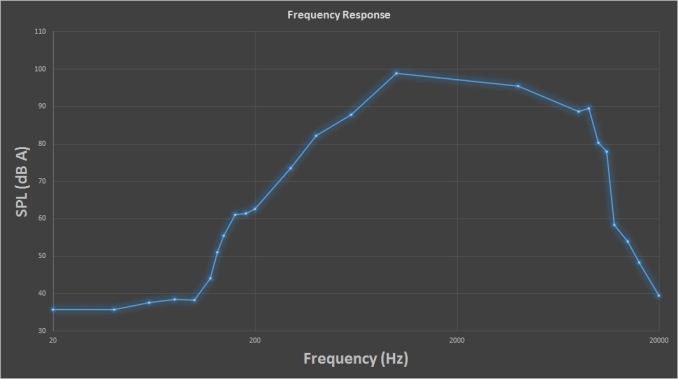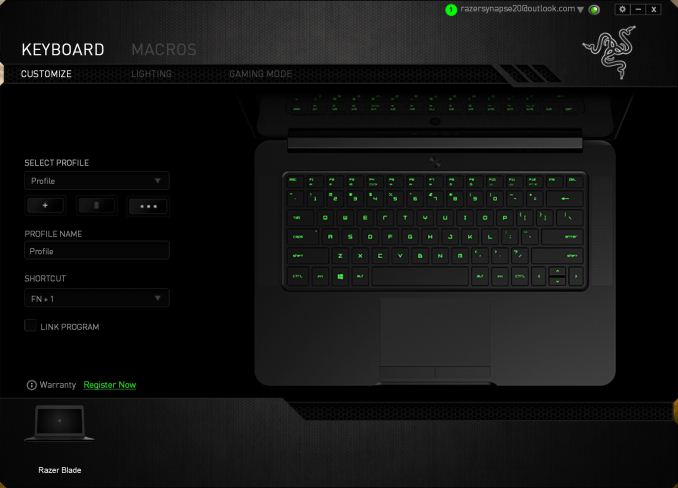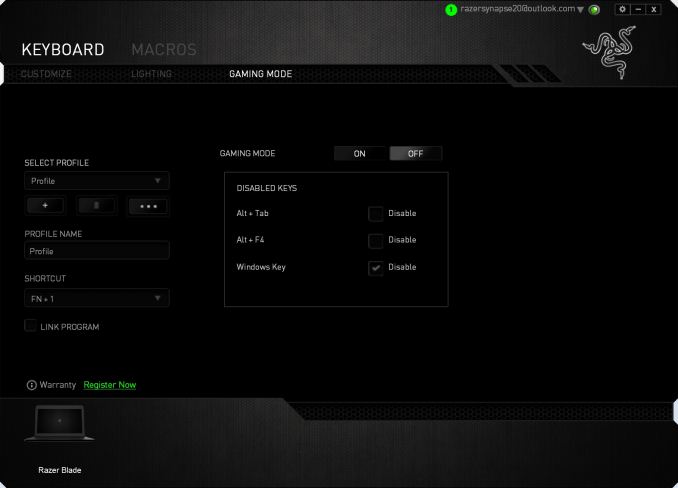The 2014 Razer Blade Review
by Brett Howse on October 10, 2014 9:00 AM EST- Posted in
- Notebooks
- Gaming
- Laptops
- Razer Blade
Speakers
The Razer Blade comes with two front facing stereo speakers. Unlike a lot of laptops that are this thin, the speakers are not down firing so you do get a better sense of stereo space. As with most laptop speakers, they do not have very good low end output, with a pretty sharp drop off below 200 Hz. At maximum volume playing some music, the Blade was able to achieve right around 80 dB.
Needless to say, I would not replace my home theater with this laptop. The front facing stereo speakers are great if you are watching a quick video, but if you want better quality sound it's best to pair the laptop with some headphones, which will also help when gaming to keep the fan noise subdued.
Software
Razer has done a great job by not including any of the software you often see from other OEMs. For many of us, the first few hours with any new device is spent removing all of the unwanted trial-ware that gets shipped. On a system with this price tag, it is good to not see any of that. They do however have some of their own custom software that you can use to customize the keyboard functions, create macros, enable Gaming Mode, and adjust the lighting. It's simple, it looks good, and it works well.
My only complaint with the software is that it requires you to create an account with Razer in order to use it. If this was optional, it would be fine, but it is not, which is disappointing.















69 Comments
View All Comments
lyeoh - Saturday, October 11, 2014 - link
What's the display and other IO latency? What tests did you use for your graphics ghosting test?Calista - Saturday, October 11, 2014 - link
Hi Brett!How well does the screen deal with gaming at non-native resolutions. A major advantage of high-dpi displays is obviously the fact it brings us closer to the way a CRT screens behave with fixed resolution all. With such high pixel density and a normal viewing distance of >60 cm I would expect also odd resolutions to look great in their own right.
Brett Howse - Sunday, October 12, 2014 - link
I only ran it at 1600x900 which is a perfect 2:1 interpolation, and it looked fine. Hard to say if it would be as good as a native 1600x900 panel but to my eyes, it looks good enough if you do need to run it at that resolution. Gaming at 3200x1800 was absolutely fantastic though it was an amazing experience. Everything is just so sharp.fancypr007 - Sunday, October 12, 2014 - link
What's funny is how the previous model used a 1600x900 TN panel screen and at the time the excuse Razer's CEO gave for using it vs using a superior IPS panel was; "this is a gaming laptop and we wanted to use the best screen for gaming."Now they're using a panel that for modern games, you'll never be able to push at anywhere near native resolutions with the included graphics card. Marketing doublespeak.
CaptainCupcakes - Thursday, October 30, 2014 - link
The reasoning for the new QHD+ display was to prove a point of what Razer is actually capable of. The logic behind last year's screen resolution was that if they used a screen that could not outpace their GPU, that the computer would have great performance. They answered the cry of the people with the new display.vol74 - Wednesday, October 15, 2014 - link
Best laptop I've ever owned. But Razer made one glaring oversight - they didn't provide a way to disable the trackpad. It's pretty aggravating when a stray thumb triggers it when gaming. Razer support recommended disabling it via the device manager. Unbelievable. Hey Razer, how about an option in Synapse to disable the trackpad when an external mouse is detected?HiTechObsessed - Wednesday, October 15, 2014 - link
Crazy expensive. You can get the CyberPowerPC thin-and-light with an 870m for $1100, and even has a slightly better CPU. This is ungodly expensive, for lower gaming performance.synaesthetic - Monday, October 20, 2014 - link
What's the point of that absurd resolution if the GPU can't even push games at 1920x1080 to a decent framerate? You're just going to have to play the games in 1600x900 anyway to get any kind of decent performance, so why bother with the super-high resolution panel if it's not even going to get used?The only logic I can detect behind this decision is that the resolution is exactly four times that of 1600x900 and would scale down to that resolution without interpolation.
ins1dious - Wednesday, November 5, 2014 - link
Seeing as how you compared the 2014 Blade to an rMBP on weight, build, battery etc... can you include the gaming scores for the rMBP as well? Obviously under bootcamp... curious as to how far behind the rMBP's 750M performance is